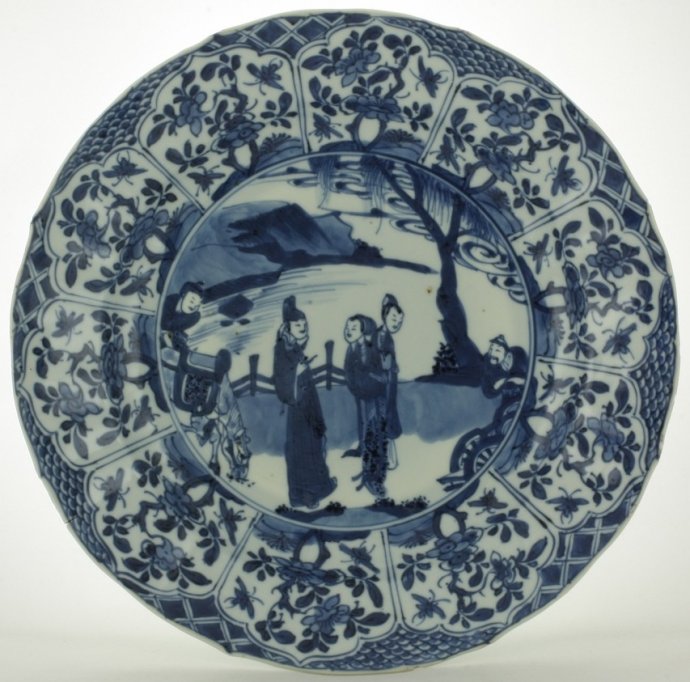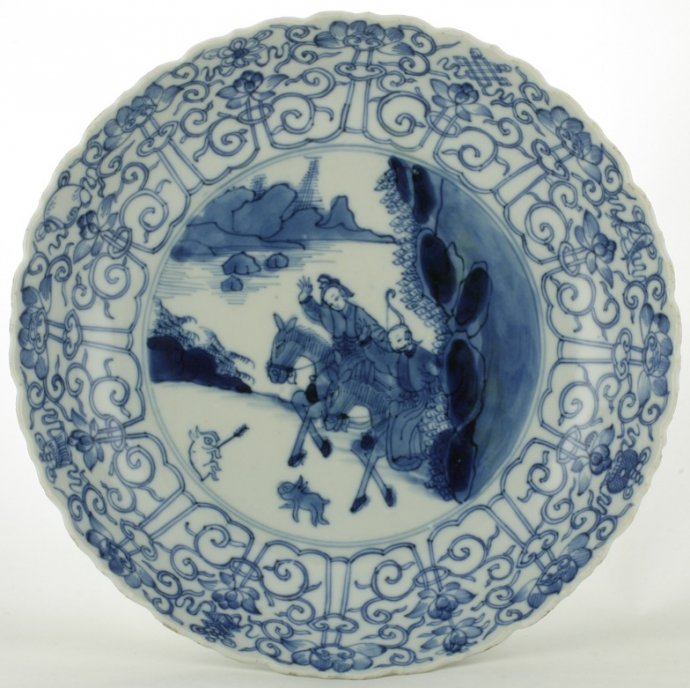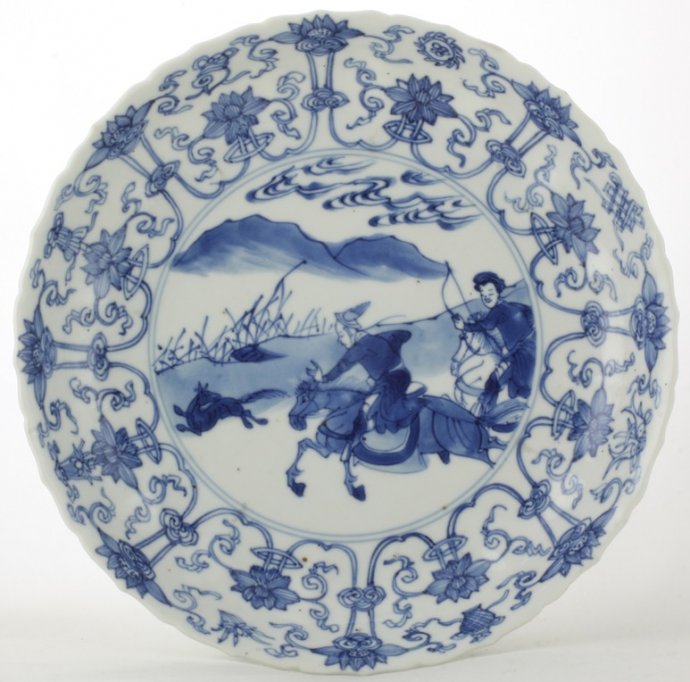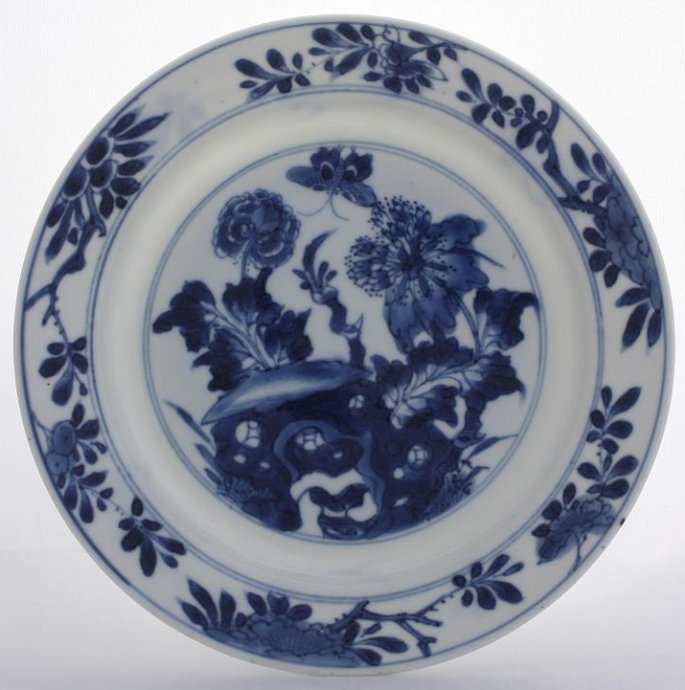Sold Ceramics
Sold Blue and White Kangxi Period 1662-1722
Dishes
Page 1
Around 1680, Emperor Kangxi (1662–1722) established his authority over all parts of China after a long period of civil strife. The porcelain factories in Jingdezhen that were demolished in 1675 resumed production and within a few years exports were booming. Chinese junks sailed to Batavia, bringing their porcelain to the market. From there, it was shipped to the Netherlands in VOC (Dutch East India Company, 1602–1799) vessels. However, private individuals bypassed the Company and also imported huge quantities of porcelain to Holland. In Europe, a change in dining habits and the introduction of tea and coffee created new demands. New varieties of Chinese export porcelain were produced, including all kinds of Western shapes. Porcelain, sometimes in miniature, was frequently used to decorate house interiors in Europe.
Much porcelain of this period is decorated in a clear, transparent underglaze blue. Popular decorations included the Buddhist lotus motif, a pheasant with long tail feathers on a rock amidst flowers, and the ‘Long Eliza’ with the 'Dancing Fool', the Dutch name for a Chinese lady and a small boy depicted in a garden.
Kangxi porcelain is very well made, with a thin body, a balanced shape and a smooth glaze without impurities. Cobalt blue oxide was subtly applied in varying degrees of saturation, suggesting depth and volume. The colour ranges from a silvery to a deep dark blue; in the best pieces the details and the craftsmanship are amazing. However, due to stricter controls by officials, the freedom and easy way of painting that was so characteristic of the preceding Transitional period now gave way to a more formal style with an emphasis on symmetry and centralism.

Sold Ceramics - Sold Blue and White Kangxi Period 1660-1722 - Dishes - Page 1
Object 2010555
Dish
China
1700-1720
Height 42 mm (1.65 inch), diameter of rim 278 mm (10.95 inch), diameter of footring 150 mm (5.91 inch)
Dish of moulded form on footring, flat rim with a foliated edge. Decorated in underglaze blue with a scholar and his servant, two ladies, a horse and a sedan-chair in a fenced landscape with a pine tree, clouds and mountains in the background. On the sides ten moulded petal-shaped panels, each enclosing a flowering plant issuing from taihu (garden) rocks with an insect in flight. Around the rim a trellis- and scale-pattern border. On the reverse three flower sprays. Marked on the base with the symbol mark 'Mandarin mark of honour', in a double circle, underglaze blue.
Romance of the Western Chamber
The love story' Romance of the Western Chamber' (Xixiang ji) ranks among the most famous literary works of China. Its importance for young people can be compared to that of Shakespeare's 'Romeo and Juliet' in the West. 'Romance of the Western Chamber' was written by Wang Shifu (1260-1336). There already existed a short story in the Tang dynasty titled 'Biography of Yingying' (Yingying Zhuan) by Yuan Zhen (779-831), but Wang Shifu adapted it by adding details and giving it a happy rather than a sad ending. It tells the story of a forbidden love affair between the civil servant Zhang Sheng, who is gifted, but of a poor family background, and the pretty Cui Yingying, daughter of the Prime Minister. The two young people have their first encounter in a Buddhist temple, where Yingying and her mother have taken lodgings when accompanying the coffin of the recently deceased father back home. Suddenly, the temple is besieged by a local gang of outlaws, who demand the daughter to be handed over. Yingying's mother promises her daughter's hand in marriage to whoever saves the daughter from falling into the hands of the gang leader. However, when Zhang succeeds in doing so with the help of General Du, his childhood friend, she does not keep her promise. The young couple start a secret affair, supported by Hongniang ('Lady in Red'), Yingying's maid. When Yingying's mother discovers the affair, she consents to the marriage on the condition that Zhang passes the final examination for the highest position in the civil service of the capital, Zhang does so well, that he is granted a top position. (Suebsman 2019, p.43)
On this dish we see how the talented but improvised student Zhang takes his farewell of Yingying and her maid Hongniang in order to travel to the capital, where he will be taking his public service exams. That is the condition set by Yingying's mother for her consent to their marrying. Zhang's sedan-chair stands ready while his servant prepares the luggage (the pile of scholarly books). (Jörg 2011/2, p.101, Scene 20)
For identically shaped, sized and decorated dishes, please see:
For similarly decorated dishes, please see:
- Oriental Ceramics at the Cape of Good Hope 1652-1795. An account of the porcelain trade of the Dutch East India Company with particular reference to ceramics with the V.O.C. monogram, the Cape Market and South African Collections, (C.S. Woodward, Cape Town & Rotterdam, 1974), p.36, cat. 51.
- Chinese ceramiek, catalogue Haags Gemeentemuseum, (B. Jansen, De Tijdstroom, Lochem, 1976), p.126, cat. 284.
- Kostbaar Goed van Grote Pracht. Chinees en Japans exportporselein uit de 17e en 18e eeuw, (Mr. L.C.A.M. Schölvinck, Zwolle 2010), pp. 32-33.
Condition: Two firing flaws, one to the rim and one to the base from which two hairlines originate, a small chip and some frits to the rim.
References:
Price: Sold.

Sold Ceramics - Sold Blue and White Kangxi Period 1660-1722 - Dishes - Page 1
Object 201090
Dish
China
c.1700
Height 30 mm (1.18 inch), diameter of rim 205 mm (8.07 inch), diameter of footring 115 mm (4.53 inch
Dish on footring with a flat rim. Decorated in underglaze blue with two "Long Eliza" figures standing in a fenced garden under a tree. On the flattened rim four panels containing flowering prunus branches reserved on a trellis diaper ground. On the reverse, two identical, elongated rocky shores with a pavilion. Marked on the base with the six-character mark: Qi yu bao ding zhi zhen, (Precious object of rare jade among treasured vessels (Kangxi)), in a double circle, underglaze blue.
Romance of the Western Chamber
The love story' Romance of the Western Chamber' (Xixiang ji) ranks among the most famous literary works of China. Its importance for young people can be compared to that of Shakespeare's 'Romeo and Juliet' in the West. 'Romance of the Western Chamber' was written by Wang Shifu (1260-1336). There already existed a short story in the Tang dynasty titled 'Biography of Yingying' (Yingying Zhuan) by Yuan Zhen (779-831), but Wang Shifu adapted it by adding details and giving it a happy rather than a sad ending. It tells the story of a forbidden love affair between the civil servant Zhang Sheng, who is gifted, but of a poor family background, and the pretty Cui Yingying, daughter of the Prime Minister. The two young people have their first encounter in a Buddhist temple, where Yingying and her mother have taken lodgings when accompanying the coffin of the recently deceased father back home. Suddenly, the temple is besieged by a local gang of outlaws, who demand the daughter to be handed over. Yingying's mother promises her daughter's hand in marriage to whoever saves the daughter from falling into the hands of the gang leader. However, when Zhang succeeds in doing so with the help of General Du, his childhood friend, she does not keep her promise. The young couple start a secret affair, supported by Hongniang ('Lady in Red'), Yingying's maid. When Yingying's mother discovers the affair, she consents to the marriage on the condition that Zhang passes the final examination for the highest position in the civil service of the capital, Zhang does so well, that he is granted a top position. (Suebsman 2019, p.43)
On this dish we see the two characters Yingying and Hongniang admiring flowers in the gardens of Pujiu Monastery. The student Zhang is about to see Yingying for the first time and fall in love with her. There also is an 'Red & Gold' / 'Rouge-de-fer' with iron-red, black enamel and gold version of this motif. (Düsseldorf 2015, cat. 123.1 & Suebsman 2019, p.44)
For an (almost) identically decorated dish, please see:
For an (almost) identically in 'Red & Gold' / 'Rouge-de-fer' with iron-red, black enamel and gold decorated version of this dish, please see:
Condition: Perfect.
References:
Price: Sold.

Sold Ceramics - Sold Blue and White Kangxi Period 1660-1722 - Dishes - Page 1
Object 201091
Dish
China
c.1700
Height 30 mm (1.18 inch), diameter 200 mm (7.87 inch), diameter of footring 115 mm (4.53 inch)
Dish on footring with a flat rim. Decorated in underglaze blue with two "Long Eliza" figures standing in a garden near a house. On the flattened rim five panels containing flowering prunus branches reserved on a trellis diaper ground. On the reverse, two identical, elongated rocky shores with a pavilion. Marked on the base with the six character mark "Da Ming Cheng hua nian zhi", prepared during the Chenghua reign of the great Ming Dynasty (AD 1465-1487), in a double circle, underglaze blue.
Many plates, dishes and bowls from the middle Kangxi period are carefully painted with a great feeling for detail; the scenes tell a story and have been derived from woodcut illustrations of Chinese novels and plays. Two novels The Story of the Western Chamber and The Dream in the Red Chamber are particularly noted for providing subjects. The motif on the back of the plate, a rocky shore, is found not only on good quality blue and white plates and dishes but also on famille verte; it appears to have been used in particular at the beginning of the 18th century. (Jörg 1995, pp.33-34)
Condition: Perfect.
References:
Price: Sold.

Sold Ceramics - Sold Blue and White Kangxi Period 1660-1722 - Dishes - Page 1
Object 2011007
Dish
China
1700-1720
Height 46 mm (1.81 inch), diameter of rim 227 mm (8.94 inch), diameter of footring 142 mm (5.59 inch), weight 479 grams (16.89 ounce (oz.))
Dish on footring, fluted sides and foliated rim. Decorated in underglaze blue with a hunting scene illustrating ladies armed with bows riding with hounds after hares. On the sides and rim flowering lotus buds and auspicious symbols. To the reverse sixteen panels each with a flower on a straight stem with leaves. Marked on the base with a six character mark "Da Ming Cheng hua nian zhi", Prepared during the Chenghua reign of the Great Ming Dynasty (AD 1465-1487), in a double circle.
This Amazonian pursuit made these set of dishes a favourite design over more than a decade. The Chenghua mark (1465-1487) was not intended as a forgery, but rather as a compliment to the quality of the piece and to replace the mark of Kangxi who had forbidden the use of his name on porcelain made for export after 1682, a ban which nominally remained in force until the late 19th century. (Howard 1994, p.42)
In the Netherlands this design is commonly known as Joosje te paard which is common on porcelain of the early 18th century. The sixteen panels on the reverse each decorated with a flower on a straight stem with leaves is a design that can also bee seen on dishes with the so called 'aster dishes' design. (Jörg 1982/1, p.156), (Jörg & Van Campen 1997, p.95)
For similarly decorated dishes, please see;
Condition: A hairline, three chips, four frits and various tiny rough spots to the rim.
References:
Lunsingh Scheurleer 1989, cat. 70
Price: Sold.

Sold Ceramics - Sold Blue and White Kangxi Period 1660-1722 - Dishes - Page 1
Object 2011369
Dish
China
1700-1710
Height 33 mm (1.29 inch), diameter 200 mm (7.87 inch), diameter of footring 120 mm (4.72 inch)
Dish on a footring with fluted sides and a foliated rim. Decorated in underglaze blue with a hunting scene illustrating two figures armed with bows riding with hounds after hares. On the sides and rim flowering lotus buds and auspicious symbols. To the reverse sixteen panels each with a flower on a straight stem with leaves. Marked on the base with a six character mark "Da Ming Cheng hua nian zhi", Prepared during the Chenghua reign of the Great Ming Dynasty (AD 1465-1487), in a double circle.
This Amazonian pursuit made these set of dishes a favourite design over more than a decade. The Chenghua mark (1465-1487) was not intended as a forgery, but rather as a compliment to the quality of the piece and to replace the mark of Kangxi who had forbidden the use of his name on porcelain made for export after 1682, a ban which nominally remained in force until the late 19th century. (Howard 1994, p.42)
In the Netherlands this design is commonly known as 'Joosje te paard' which is common on porcelain of the early 18th century. (Jörg 1982/1, p.156) The sixteen panels on the reverse each decorated with a flower on a straight stem with leaves is a design that can also bee seen on dishes with the so called 'aster dishes' design. (Jörg & Van Campen 1997, p.95)
For similarly decorated dishes, please see;
Condition: Perfect.
References:
Lunsingh Scheurleer 1989, cat. 70
Pinto de Matos 1996, pp.273-280
Price: Sold.
More pictures of object 201022, another identically, shaped, sized and decorated, sold dish >>
More pictures of object 2010198, another identically, shaped, sized and decorated, sold dish >>

Sold Ceramics - Sold Blue and White Kangxi Period 1660-1722 - Dishes - Page 1
Object 2011638
Dish
China
1700-1710
Height 33 mm (1.29 inch), diameter 200 mm (7.87 inch), diameter of footring 123 mm (4.84 inch), weight 200 grams (7.06 ounce (oz.))
Dish on footring with fluted sides and a foliated rim. Decorated in underglaze blue with a hunting scene illustrating two figures armed with bows riding with hounds after hares. On the sides and rim flowering lotus buds and auspicious symbols. To the reverse sixteen panels each with a flower on a straight stem with leaves. Marked on the base with a six character mark "Da Ming Cheng hua nian zhi", Prepared during the Chenghua reign of the Great Ming Dynasty (AD 1465-1487), in a double circle.
This Amazonian pursuit made these set of dishes a favourite design over more than a decade. The Chenghua mark (1465-1487) was not intended as a forgery, but rather as a compliment to the quality of the piece and to replace the mark of Kangxi who had forbidden the use of his name on porcelain made for export after 1682, a ban which nominally remained in force until the late 19th century. (Howard 1994, p.42)
In the Netherlands this design is commonly known as Joosje te paard which is common on porcelain of the early 18th century. (Jörg 1982/1, p.156) The sixteen panels on the reverse each decorated with a flower on a straight stem with leaves is a design that can also bee seen on dishes with the so called 'aster dishes' design. (Jörg & Van Campen 1997, p.95)
For similarly decorated dishes, please see;
Condition: A X-shaped hairline to the base and some tiny frits and fleabites to the rim.
References:
Lunsingh Scheurleer 1989, cat. 70
Pinto de Matos 1996, pp.273-280
Price: Sold.

Sold Ceramics - Sold Blue and White Kangxi Period 1660-1722 - Dishes - Page 1
Object 2010588
Dish
China
c.1700
Height 39 mm (1.54 inch), diameter of rim 225 mm (8.86 inch), diameter of footring 115 mm (4.53 inch)
Dish on a footring with a foliate rim. Decorated in underglaze blue. The edge in underglaze brown (jia mangkou). (Sargent 2012, p.183) Moulded in the shape of an open lotus flower with nine petals. In the centre in a round shaped medallion an attractively painted decoration of a flowering peony and chrysanthemum plant growing from a taihu rock with flying butterflies and insects. The sides divided into nine moulded petals each one filled with flowering trees, plants and flying insects. On the reverse nine moulded petals filled with flowering stems. Marked on the base with the single character mark: Yu, (Jade (Yuan to Qing)), in a double circle, underglaze blue.
The Yu, "jade", character mark is traditionally called the F-mark in the Netherlands and is very common on good-quality blue and white Kangxi export porcelain. (Jörg & Van Campen 1997, p.115)
For a similarly sized and decorated dish, please see:
Condition: A restored chip and connected hairline.
References:
Jörg & Van Campen 1997, cat. 116
Price: Sold.

Sold Ceramics - Sold Blue and White Kangxi Period 1660-1722 - Dishes - Page 1
Object 201093
Dish
China
c.1700
Height 33 mm (1.29 inch), diameter of rim 160 mm (6.29 inch), diameter of footring 75 mm (2.95 inch)
Dish on footring. A curving rim spirally fluted in eight lobes. Decorated in underglaze blue with a feng-huang or Chinese phoenix in flight amongst dense peony sprays, in the radiating panels flowering peony plants alternating with trees, on the reverse eight flower sprays. Marked on the base with the symbol mark: flower, the symbol for purity, in a double circle, underglaze blue.
This dish is a fine and characteristic example of the Kangxi cobalt-blue and style of painting. The dish imitates a common European silver form, which may however have been transmitted by way of an intermediary in delftware. (Howard & Ayers 1978, vol. 1, p.64, cat. 18)
For identically decorated dishes, please see:
Condition: Perfect.
References:
Lunsingh Scheurleer 1966, cat. 18
Lunsingh Scheurleer 1989, cat. 72
Price: Sold.

Sold Ceramics - Sold Blue and White Kangxi Period 1660-1722 - Dishes - Page 1
Object 2010189A
Dish
China
c.1700
Height 33 mm (1.29 inch), diameter of rim 155 mm (6.10 inch), diameter of footring 80 mm (3.15 inch)
Moulded dish on footring. Decorated in underglaze blue with two figures in a boat, a piece of land with a pagoda with a lantern and two figures sitting under a tent near a fence with rocks, trees, bird in flight, mountains and the sun. The foliated sides and rim is divided into two moulded rows, each with twenty-three petal shaped floral sprays. On the reverse two moulded rows, one row with twenty-three petal shaped floral sprays and one with twenty-three, left blank, petal shaped rows. Marked on the base with a square shop mark in a double circle, underglaze blue.
Condition: Five very tiny glaze fleabites and two hairlines to the rim, a tiny frit to the inner footring.
Price: Sold.
More pictures of object 2010189B, another identically, shaped, sized and decorated, sold dish >>

Sold Ceramics - Sold Blue and White Kangxi Period 1660-1722 - Dishes - Page 1
Object 201092
Dish
China
1700-1720
Height 28 mm (1.10 inch), diameter of rim 245 mm (9.65 inch), diameter of footring 138 mm (5.43 inch)
Dish on footring with a flat rim. Decorated in underglaze blue with a bird perched on a branch and flowering plants growing from a taihu rock. On the sides and rim three groups of flowering plants growing from pierced rockwork alternating with flower spays. On the reverse three flower sprays. Marked on the base with the symbol mark: Ding incense burner, in a double circle, underglaze blue. On the base an old paper label that reads; 'Leg F.J.'44' (presumably referring to a legacy of a certain F.J. in 1944)
Condition: Two frits to the rim.
Reference:
Price: Sold.
More pictures of object 2010176, another identically, shaped, sized and decorated, sold dish >>

Sold Ceramics - Sold Blue and White Kangxi Period 1660-1722 - Dishes - Page 1
Object 201023
Dish
China
c.1700
Height 27 mm (1.06 inch), diameter of rim 207 mm (8.15 inch), diameter of footring 120 mm (4.72 inch)
Dish on footring with moulded spiralling rim. Decorated in underglaze blue with flowering plants growing from a taihu rock. On the sides and rim three groups of flowering plants growing from pierced rockwork alternating with flower spays. On the reverse three flower sprays. Marked on the base with the symbol mark: Ding incense burner, in a double circle, underglaze blue.
Condition: A glaze imperfection to the inner rim and a frit to the outer rim.
Reference:
Price: Sold.

Sold Ceramics - Sold Blue and White Kangxi Period 1660-1722 - Dishes - Page 1
Object 201094
Dish
China
1700-1720
Height 24 mm (0.94 inch), diameter of rim 158 mm (6.22 inch), diameter of footring 80 mm (3.15 inch)
Dish on footring with a flat rim. Decorated in underglaze blue with flowering plants growing from a taihu rock and a single butterfly in flight. On the rim six flower sprays. On the exterior rim two flower sprays. Marked on the base with a square shop mark in a double circle, underglaze blue.
Condition: Perfect.
Price: Sold.


 create websites
create websites